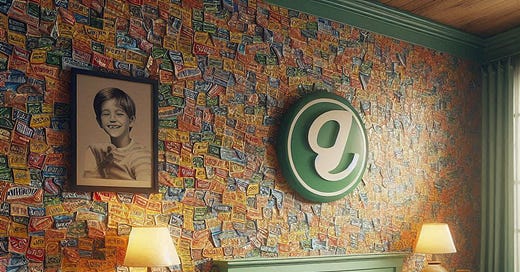Dear Friends,
Step into my study! Shall I fill you a pipe? Pour you a dram? Excellent.
You might’ve noticed there was no Square Inch Newsletter last week. It is customary for me to put together a “Year In Review” post around December 31st, and I almost did get it done. But it didn’t feel right to me. I am endeavoring to write with more positivity and optimism, and for some reason what I found myself writing was negative and depressing. Even my attempt to explain to you why I want to avoid negativity was … negative. So I mothballed the whole post.
Suffice it to say: I keep promising that this is the “last time” I write about the Nazi-adjacent, ethno-nationalist fever swamp and then I keep on writing about it. As a matter of accountability I am telling you that I am endeavoring to be done with the whole scene. (Now I’ll be hesitant to write about it in this space, you see.)
As a final send-off, I will link to this essay, published just this morning, by Douglas Wilson. It is a fine piece of work with a stiff warning to the anonymous armies of “whiteness.” That essay also marks, as far as I can tell, the end of a thirty-year experiment in something Doug himself labeled, “A Serrated Edge.” John Frame’s review of that book has been profoundly vindicated. Frame concluded: “Given the confusion this book is likely to create, I think the best advice Doug gives us is ‘don’t try this at home.’” Indeed. We now know where it leads.
Let us talk of pleasanter things.
The other night Bailey was continuing our read-aloud of Harry Potter and the Order of the Phoenix. This isn’t the space for me to give the customary “apologia” for why you ought to read JK Rowling’s epic masterpiece, so I’ll just say it and move on: you really should read JK Rowling’s epic seven-novel masterpiece.
I have been through this series many times, including having read the whole thing aloud to the older girls—accents, voices, and all. Bailey is now trying her hand at voice acting and it is an unparalleled delight. So the other night we happened across chapter 23, “Christmas on the Closed Ward.” And it was so deeply moving I found myself weeping.
Rowling’s ability to move from mirth and hilarity to stone-cold seriousness is incredible. Her ability to unlock and display human psychology is, frankly, unparalleled (this is true of her detective series, as well.) The way 15-year-old Harry jumps to conclusions, assumes his “perception is reality,” devolves into endless self-pity, never ceases to amaze me. All of her characters are like this: that’s exactly how someone would react. The realism of her work astounds. And this is all on display on Christmas on the Closed Ward.
Hopefully, these will not be catastrophic spoilers. Mr. Weasley has been grievously injured and is laid up in St. Mungo’s Hospital for Magical Maladies and Injuries, and the whole crew of Weasleys, along with Harry and Hermione, go to visit him on Christmas Day. Ron, Harry, Hermione, and Ginny all head up to the 5th floor to the cafeteria. In the stairwell, they bump into a familiar man wandering out of his ward: Gilderoy Lockhart, their former professor who famously lost his mind due to a backfiring spell from Ron’s wand in a previous book. The scene is hilarious. Lockhart is the same old Lockhart, offering them autographed photos of himself, only now he can’t remember why and is proud that he has now learned to write “connected letters.” See, that’s funny and also really, profoundly sad at the same time.
Keep reading with a 7-day free trial
Subscribe to The Square Inch to keep reading this post and get 7 days of free access to the full post archives.





